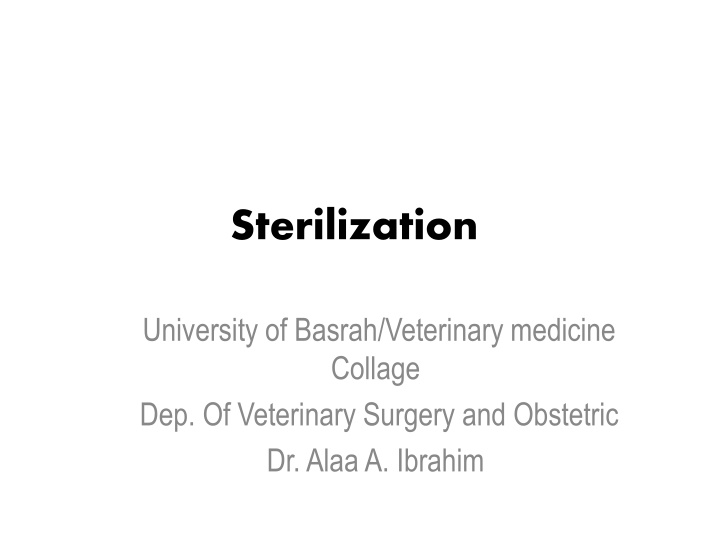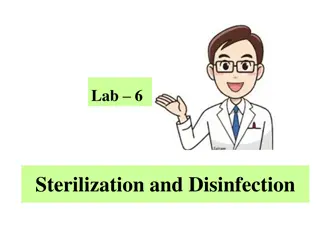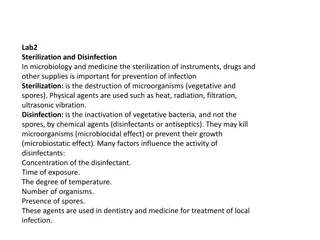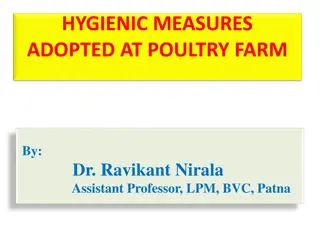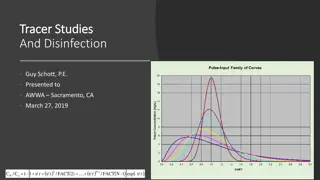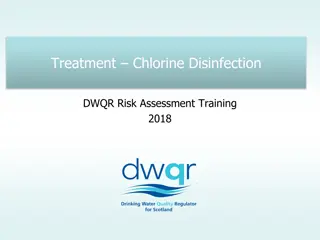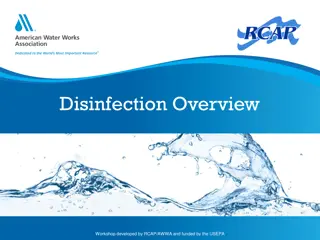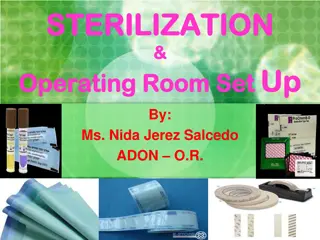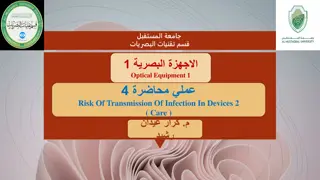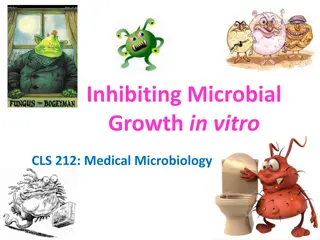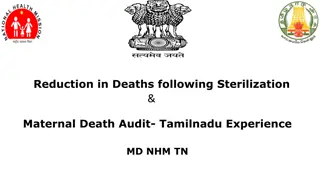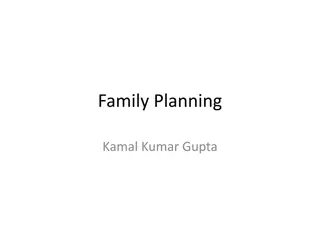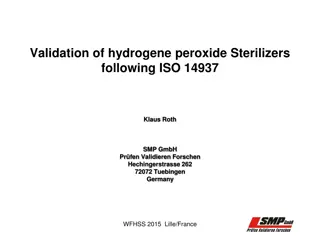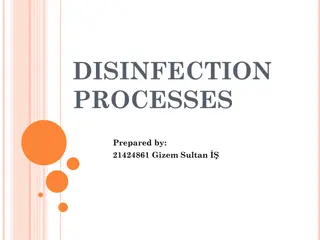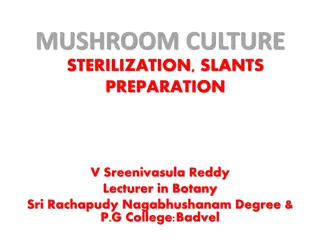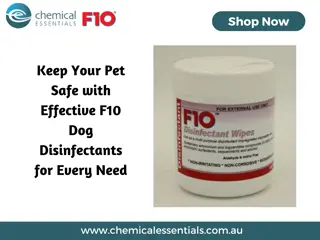Guidelines on Sterilization, Disinfection, and Types of Disinfectants in Veterinary Medicine
Sterilization is the process of eliminating all microorganisms from an object, while disinfection reduces the number of pathogenic microorganisms on surfaces. Various types of disinfectants exist, including high-level, intermediate-level, and low-level options. Different equipment items in veterinary practices require specific sterilization or disinfection methods based on their level of risk. Liquid chemical germicides like glutaraldehyde are commonly used for cold sterilization, although their effectiveness may be limited in certain scenarios.
Download Presentation

Please find below an Image/Link to download the presentation.
The content on the website is provided AS IS for your information and personal use only. It may not be sold, licensed, or shared on other websites without obtaining consent from the author.If you encounter any issues during the download, it is possible that the publisher has removed the file from their server.
You are allowed to download the files provided on this website for personal or commercial use, subject to the condition that they are used lawfully. All files are the property of their respective owners.
The content on the website is provided AS IS for your information and personal use only. It may not be sold, licensed, or shared on other websites without obtaining consent from the author.
E N D
Presentation Transcript
Sterilization University of Basrah/Veterinary medicine Collage Dep. Of Veterinary Surgery and Obstetric Dr. Alaa A. Ibrahim
Sterilization :- is the process of destroying of all microorganism (bacteria, viruses, fungi , and prions) in or on an object .Sterilization can occur through physical or chemical means Antiseptic :- is the substances that stop or slow down the growth of microorganism on living objects Disinfection:- is the process that eliminates many or all pathogenic microorganisms (except bacterial spores ) on inanimate objects.
Types of disinfectants High-level disinfectant:- are those that kill any microorganisms present, with the exception of large numbers of bacterial spores (e.g., 20 minutes for 2% Glutaraldehyde). Intermediate-level disinfectants :- Typically will not kill bacterial spores but kill mycobacteria, vegetative bacteria, most viruses, and most fungi Low- level disinfectants : can kill most vegetative bacteria, some fungi, and some viruses in a practical period of time
Equipments (Items ) Critical equipment :- are those associated with high risk of infection when they become contaminated .These includes items such as surgical instruments, catheters, needles, and implants, all of which should be sterilized Semi-critical items :- are those that come in contact with mucous membranes or skin, such as laryngoscopes and esophageal probes. These items should be subjected to sterilization or high-level disinfection Noncritical items:- are those that contact only skin, such as stethoscopes and gurneys( ). These items can be disinfected with low-level disinfectants
Types of Sterilization Liquid chemical germicides (cold sterilization ) Soaking instruments or other equipment in a disinfectant (frequently a liquid ) Decrease the ability to access microbes in the interior or crevices when compared with thermal sterilization Their used is limited Most chemical liquid sterilants do not have an appropriate biologic sterility indicator not advised for surgical equipment or other items that, if contaminated, would carry the risk of highly significant sequelae Use with endoscopic equipment Liquid chemical germicides (cold sterilization )
Liquid chemical germicides ( Glutaraldehyde, one of the most frequently used chemical sterilants, has reasonable efficacy against bacterial spores, but only with prolonged exposure Glutaraldehyde is considered a high-level disinfectant but is too expensive to be used on noncritical items and irritating to the respiratory passages Liquid chemical germicides (cold sterilization ) cold sterilization ) Formaldehyde is available as a 37% aqueous solution (formalin). It is slightly less efficacious than glutaraldehyde and is considered a carcinogen(poor candidate for most clinical application Hydrogen peroxide (producing hydroxyl free radicals to interfere with membranes and nucleic acids) can be used as chemical sterilants but must be store in dark container to prevent loss of efficacy and also can be consider toxic to mucous membranes and can discolor some metals .
Steam sterilization Steam sterilization the most common method preferred method for items that are heat and moisture stable operate under a balance of steam, pressure, temperature, and time kill microorganism through coagulation and denaturation of proteins by moist heat . inexpensive, efficacious (including against spores), nontoxic, and rapidly effective with a variety of materials
Autoclaves Gravity-displacement sterilizer is the most common autoclave used in veterinary practice (typical temperature 1210C for 30 minutes ) steam introduced under pressure, being lighter than air, stays at the top and forces air out through a valve at the bottom .
Autoclaves Prevacuum steam sterilizer Prevacuum steam sterilizer its function is similar to gravity-displacement sterilizer with the exception that a pump is used to remove air before the steam is admitted and typical temperature 1340C for 4 minutes. This allows for very rapid and uniform steam distribution within the chamber.
low- -temperature steam formaldehyde sterilization involves the introduction of formaldehyde vapor and saturated steam into a prevacuum chamber The temperature is maintained at between 65- 80 before the system is purged with air. low temperature steam formaldehyde sterilization
Flash sterilization Flash sterilization Rapidly sterilizing items that are needed for immediate use and therefore cannot be subjected to the normal protocol involves a steam autoclave that is programmed to use a higher temperature and a shorter time cycle General guidelines for flash sterilization of metallic nonporous (no lumens) items in a gravity-displacement autoclave include 3 minutes of exposure time at 135 C with 1 minute of drying time
Ethylene oxide( Ethylene oxide(EtO EtO) ) sterilization: sterilization:- - Is low- temperature sterilization method involve using of ethylene oxide gas (EtO)is colorless and odorless and has boiling point of 10.5 C. mode of action is by alkylation of protein and nucleic acid thereby obstructing cell metabolism and reproduction used for items that cannot be sterilized by steam sterilization. EtO is flammable( so it usually mixed with carbon dioxide orhydrochloroflourocarbone) ,toxic , carcinogenic, mutagenic, and neurologic hazard .So EtO use will likely decrease because of these disadvantages.
Ozone sterilization : Ozone sterilization :- - used for heat-sensitive items Ozone is generated from oxygen and water during sterilization cycle and then converted back to nontoxic compounds . the ozone molecules (O3) is contain loosely bound third oxygen molecule which readily oxidizes other molecules to cause destruction of microorganism. Ozone sterilization is not suitable for paper , wood, and packaging .
Plasma sterilization : Plasma sterilization :- - Plasma sterilizer use electromagnetic energy to create a plasma phase from a vapor of hydrogen peroxide, oxygen, or peracetic acid/hydrogen peroxide mixture. . The plasma contains reactive products such as free radicals that deactivate cellular processes Plasma sterilizers are rapid and effective, but high cost may be a concern useful for moisture- or heat sensitive items but should not be used for linens, liquids, or wood products
Sterilization by radiation : Sterilization by radiation :- - Gamma irradiation is also used to sterilize surgical items Their use is limited (expensive ) Items such as suture and certain implants are often sterilized by radiation.
Indictors of sterilization Indictors of sterilization Sterilization monitors are used to evaluate the efficacy of the sterilization process These monitors may be physical , chemical , or biological monitors. Physical monitors are associated with specific sterilization unit Chemical monitors react to specific parameters that are critical for sterilization typically by color change.
Chemical monitors are divided into six classes: Chemical monitors are divided into six classes:- - Class 1indicator such as sterilization tape applied to the outside of a surgical pack indicates that the pack has been processed Class 2 indicator test for air removal and is known as Bowie-Dick test Class 3 indicator react to specific parameters such as temperature or time Class 4 indicators react to more than one parameters Class 5 indicators react to all parameters that are important to a given type of sterilization .Class 5 indicator placed in the deepest portion of the pack. Class 6 indicators, the newest class, have been designed to monitor more specific guidelines associated with a unique indication such as the parameters required to combat prion infection, or those associated with particular instrument.
Biological indicator is the best method of determining is the sterilization protocol being followed is effective This test consist of culturing microorganism that evaluated post processing to determine viability Typical biologic indictors require 16 hours to 7 days of incubation. Some biologic indicators can be evaluated in 1 hour; these are termed rapid-action indicators
